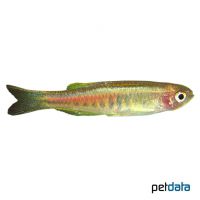Glowlight Danio (Danio choprae)
| Glowlight Danio Danio choprae | |
|---|---|
| Name | Glowlight Danio |
| Name Lat. | Danio choprae |
| Synonym | Celestichthys choprae |
| Family | Danios |
| Family lat. | Danionidae |
| Order | Carps |
| Order lat. | Cypriniformes |
| Origin | Myanmar |
| Habitat | Forest streams |
| Diet | Carnivore |
| pH | 6.0-8.0 |
| Behavior | Peaceful |
| Keeping | Group |
| Care Level | Moderate |
| Reproduction | Egg scatterer |
| Breeding | Difficult |
| Life Span | 2-5 years |
| Protection | No |
| Metric Units | |
| Size | 3 cm |
| Temperature | 18-26 °C |
| Hardness | 2-10 °dH |
| Aquarium | ~ 100 l |
| US Units | |
| Size | 1.2" |
| Temperature | 68-79 °F |
| Hardness | 36-178 ppm |
| Aquarium | ~ 25 gal |
Distribution and habitat
The distribution area of the ruby danios is the Irawadi inlet in the north of Myanmar. There they live in the clear, oxygen-rich mountain streams as well as in the larger, slow-flowing tributaries with coarse sandy bottoms between stones and rocks.
Maintenance
The aquarium should have a border planting, with hiding and retreat possibilities (roots, stones) and offer a lot of swimming space. A coarse, round gravel as substrate with some foliage covered (e.g. sea almond leaves) and a weak current is ideal.
No ammonia, ammonium and nitrite should be detectable, the nitrate value should not exceed 100 mg/l. To ensure the water quality and oxygen content, a filter and heater adapted to the aquarium size is required, as well as lighting for the species-appropriate day-night rhythm of the animals.
Diet
In nature they feed mainly on insects and insect larvae. The food supply consists of live, frozen and dry food. For a balanced diet, feed once a day with a high-quality, protein-rich dry food (flakes, granules, pellets) as well as cyclops, moina, daphnia, artemia, mosquito larvae, etc. (live or frozen)
It is recommended to feed small portions several times a day. Only feed as much as will be eaten within a few minutes. A regular and varied diet promotes health and increases resistance.
Behaviour and compatibility
They are swimming and lively fish that are well suited for a community tank with small peaceful fish. They have a highly developed social structure and should therefore be kept in a group of at least 8-10 animals.
Basically, only mutually compatible fish species with similar requirements for water conditions and water temperature should be socialized.
Sex dimorphism
Males are smaller, slimmer and more intensely colored than females.
Reproduction and breeding
They are free spawners. The male usually swims around (drifts) the female in the early morning, which spawns among fine-feathered plants. The larvae hatch after about 72 hours and swim freely after a few days. The parents do not engage in brood care and should be separated from the fry after spawning, as they are spawn predators.
Fry must be fed several times a day with special rearing food (Artemia nauplii). In community tanks breeding is hardly possible, because the spawn is easy prey.
Important
The tank should be well covered, as they like to jump.
The foliage (sea almond tree, oak, etc.) when rotting promotes the development of microorganisms, which are a valuable secondary food source.
The well-being of the fish should be monitored regularly. Temperature should be checked daily, pH, hardness and nitrate levels should be checked at least every 14 days. Regular partial water changes are recommended, even when contaminant levels have not yet reached the upper limit. Sudden changes in water quality should be avoided. Newly introduced fish must be accustomed slowly to the water in the aquarium.
Further literature can be found in your pet store.
References
Text: Werner Winter; Image: petdata
Source: BMELV (1998): Tierschutzgutachten - Haltung von Zierfischen (Süßwasser); ENGELMANN (2005): Zootierhaltung - Tiere in menschlicher Obhut: Fische, Verlag Harri Deutsch
- Gemäß § 21 Abs. 5 Tierschutzgesetz idgF
